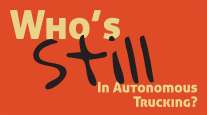ELDs from A to Z

This story appears in the May 9 print edition of iTECH, a supplement to Transport Topics.
Carriers that haven’t yet implemented electronic driver logs will be sifting through a plethora of different hardware and software options as they plan how to comply with the upcoming federal mandate of the technology.
The industry’s expanding menu of electronic logging devices ranges from fleet-management systems that offer many functions to improve safety and efficiency to more basic products designed mainly to record driver hours and keep carriers in compliance with the ELD rule.
That regulation, issued late last year by the Federal Motor Carrier Safety Administration, will require nearly all drivers currently using paper logbooks to transition to e-logs to record driver hours by Dec. 18, 2017.
“It’s a big deal,” Clem Driscoll, a telematics industry analyst, said of the mandate.
RELATED STORY: ELD Vendors to Self-Certify Devices as Compliant ELDs
BEST OF MAY iTECH: More stories, columns
Many small- to midsize fleets that have been thinking about purchasing a GPS fleet-management system will move forward with those plans now that the ELD deadline has been set, said Driscoll, who is president of consulting and research firm C.J. Driscoll & Associates.
The onboard technology business has been evolving in anticipation of the ELD mandate.
Longtime suppliers of in-cab technology have been broadening their product offerings, while new entrants have been jumping into the market, a trend likely to continue as the deadline approaches.
ELD buyers will be able to choose from a variety of in-cab hardware options. In addition to the traditional hardwired, fixed-mount displays often used with onboard computers, a growing number of e-log systems use mobile devices such as tablets and smartphones as the display.
Regardless of the hardware type, a compliant ELD must connect with the engine’s electronic control module to automatically collect data. If a mobile display is to be used, the rule requires that the device be docked during driving.
Many owner-operators and small fleets still use paper logs and will need to install a system to comply with the ELD mandate, Driscoll said.
A large number of the largest trucking companies, however, especially truckload carriers, already use telematics systems, “so a lot of them have the ability to monitor hours of service already in place,” he said.
Under the mandate, operators running e-logs on systems that meet current specifications — known as automatic onboard recording devices, or AOBRDs — can continue to do so until Dec. 16, 2019, an additional two years beyond the compliance date.
Several onboard technology suppliers have expanded their product lines recently.
Earlier this year, Omnitracs introduced its Intelligent Vehicle Gateway, or IVG, designed to act as a communications hub connecting various sensors and devices on the truck, including smartphones and tablets.
That product is the successor to the company’s Mobile Computing Platform product line.
Omnitracs has long offered flexible usage programs enabling customers to tailor the functionality and cost of their systems to meet their needs, said Tom Cuthbertson, vice president of regulatory compliance.
Fleets can select from tiered pricing plans to activate more features such as diagnostics, fuel management and so on.
“You can turn them on and turn them off,” Cuthbertson said. “If someone wants to start out with more of a basic system and not take advantage of fuel-tax reporting and things like that, they don’t have to do that up front.”
About 18 months ago, Omnitracs greatly expanded its mobile device-based products by acquiring XRS Corp. The Omnitracs XRS application, which can provide e-logs and other fleet-management functions, runs on smartphones and tablets in conjunction with a black box that communicates with the engine.
Telematics systems provided by PeopleNet typically have used proprietary or ruggedized displays with “everything hardwired to the engine,” said Elise Chianelli, the company’s director of safety and compliance.
The PeopleNet Display.4, or PD.4, is an example of that hardware approach.
Since the publication of the mandate, however, the company has expanded its product offering to operate with the Samsung Galaxy Tab A, an “off-the-shelf” consumer tablet, Chianelli said.
PeopleNet also plans to certify additional types of tablets to work with its onboard computers, she added.
Technology providers also are offering basic, compliance-focused ELDs aimed at small trucking companies.
Continental Corp.’s VDO RoadLog product, for example, has no wireless connectivity but features a built-in thermal printer and a USB port for data transfer.
There is no monthly service charge. During roadside inspections, the driver prints the log and hands the printout to an enforcement officer. The driver’s USB drive doubles as a key to the ELD, allowing him or her to log in and out, said Alexis Capelle, ELD program manager with Continental’s commercial vehicles and aftermarket segment.
Continental is marketing the system to small fleets and owner-operators, who are “really just looking for something that makes them compliant to the rule in the most cost-effective way possible,” said Jay McCarthy, who handles business development and marketing for VDO RoadLog.
The cost per vehicle, including back-end software and cables to connect the unit to the diagnostic port, is under $700, McCarthy said.
For fleets, Continental recently added a version of the product that includes a cellular chip for wireless connectivity and adds a $20 monthly subscription for cloud-based hours-of-service software.
Rand McNally has introduced a low-cost device designed to make it easy for owner-operators and small carriers to comply with the mandate.
The company’s new ELD 50 device, designed to be paired with Android smartphones and tablets, plugs into a truck’s diagnostic port below the dash and uses a Bluetooth connection to send HOS data to a free mobile app for viewing hours and driver vehicle inspection reports.
It is priced at $150 plus a $15 monthly subscription and is sold at travel centers and online, the company said.
Meanwhile, Rand McNally is making software updates to its existing products, including its HD 100, to bring them into compliance with the ELD mandate, said Ravi Kodavarti, director of commercial products.
Some carriers have deployed e-log devices in recent months to get a jump on the mandate.
One such company is Nebraska Transport Co., which installed telematics systems on 120 tractors over a two-month span last fall.
“We moved forward early so we’d have time” to implement the system’s range of capabilities, which include engine diagnostics and trip reports, said Josh Lacy, director of operations at the Gering, Nebraska-based fleet.
“We had the opportunity to have all this at our fingertips, and we couldn’t pass it up,” Lacy said, noting that the carrier previously had used paper logs.
Lacy said he looked at eight to 10 systems over a couple of weeks, calling vendors for information, before settling on a product from Zonar Systems that uses an Android tablet that rides in a dock mounted on the dash and connects with the engine as stipulated in the mandate. Drivers can remove the tablet and use it as they walk around the truck to perform pre- and post-trip inspections.
“We’re still learning,” Lacy said four or five months after all of the units had been installed. “It’s not something that just happens overnight.”
Some drivers are still adjusting to certain steps such as logging on and off duty and signing out of the tablets — “very basic stuff,” Lacy said, “but we’re human and it takes time.”
The fleet has time to work through that learning process because it implemented the technology early.
To have waited until late next year, near the deadline, would have been “a hardship on our drivers and teammates,” Lacy said.
Zonar’s tablet manages driver hours and issues warnings when he or she is almost out of time or needs to take a break, said Fred Fakkema, the company’s vice president of compliance.
“[Four years ago], there were really about six, maybe eight, telematics companies that did hours of service and did it well,” said Fakkema, whose knowledge of HOS enforcement stems from a previous career with the Washington State Patrol. “When you look at it today, there are about 40 vendors out there who say they’re going to be ELD-compliant. They’ve really popped up since the mandate came out.”
Metal supplier Olympic Steel in Bedford Heights, Ohio, finished installing a compliance-focused e-log device on the company’s 50 leased power units just over a year ago, said Ron Brown, corporate transportation manager.
The system, the J. J. Keller Encompass E-Log, is compatible with iPhone, iPad and Android smart devices. With an app installed, the driver’s smart device communicates via Bluetooth with the ELD.
Olympic Steel issued its drivers Android tablets purchased for less than $200 each and fitted with protective covers, Brown said. Drivers carry them as they walk around their trucks to conduct pre- and post-trip inspections.
If a tractor goes out of service, the company installs a spare ELD in a rental truck. When moving to a rental unit, Brown said, “All the driver has to do is connect up to it, using his tablet.”
The Encompass software also enabled a reduction in paperwork at Olympic Steel’s office, he said.
“We allow people from our leasing company to log in and run the reports that they need to run,” such as those for state fuel taxes, Brown said. “We no longer have to provide all that manually.”
J. J. Keller charges $199 for the ELD box that connects to the engine’s diagnostic link, said Kevin Smith, a regional sales manager at the company.
Another telematics provider, CarrierWeb, is one of a number of vendors updating their software to comply with the mandate.
CarrierWeb offers a fixed in-cab device mounted to the dash. The company also is developing, for release this summer, a portable device that drivers will be able to carry outside of the cab, said Keith O’Brien, vice president of product management and professional services.
Later this year the company also will introduce its own tablet version, designed to sit in a cradle, O’Brien added. It will have the “brains” of the fixed-mount system and display the same data, he said.
Pete Allen, executive vice president of sales at MiX Telematics, said the company plans to update its software to meet the mandate’s specifications, but will require no changes to its current hardware platform.
MiX Telematics’ system features a fixed Android display connected to the onboard computer, but the company is exploring things such as tablets and smartphones for future development, Allen said.
Kelly Frey, vice president of product marketing for Telogis, said that because the company’s telematics system is built on an open platform, it has a lot of flexibility to adapt to regulatory changes.
Telogis software is available on the telematics hardware factory installed in Volvo and Mack trucks — the same hardware used by the truck makers’ remote diagnostics platforms.
Operators that implement the Telogis system pay a subscription that covers the software and hardware, Frey said. ³




